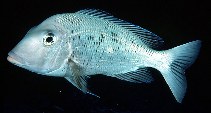| Family: |
Lethrinidae (Emperors or scavengers), subfamily: Monotaxinae |
| Max. size: |
45 cm TL (male/unsexed) |
| Environment: |
reef-associated; marine; depth range 15 - 50 m, non-migratory |
| Distribution: |
Western Pacific: including southern Japan, South China Sea, Australia, Coral Sea, New Caledonia, and Tonga. Recently reported from Norfolk Island (Ref. 8881). |
| Diagnosis: |
Dorsal spines (total): 10-10; Dorsal soft rays (total): 9-10; Anal spines: 3-3; Anal soft rays: 9-10. Description: Eye is relatively large, its lower edge well above a line from the tip of the snout to the middle of the caudal fin fork. Caudal fin is moderately forked and with blunt tips. Overall color is silvery white to grayish. The scales of the back and sides have a small brownish basal spot. Prominent black blotches are scattered mainly on the anterior half of the body. A very faint bar is sometimes present below the eye to the lower edge of the cheek. Fins are clear to reddish, the caudal fin sometimes dusky reddish-brown. Faint spots may be evident on the dorsal, caudal, and anal fins (Ref. 2295). Body depth 2.4-2.5 in SL (Ref. 90102). |
| Biology: |
Occurs over sand and rubble areas adjacent to rock and coral reefs in lagoons and outer slopes (Ref. 9775, 90102). Feeds on bottom-dwelling gastropods. Also caught with bottom longlines and handlines (Ref. 9775). Marketed fresh. |
| IUCN Red List Status: |
Least Concern (LC); Date assessed: 09 March 2015 Ref. (130435)
|
| Threat to humans: |
harmless |
Source and more info: www.fishbase.org. For personal, classroom, and other internal use only. Not for publication.
